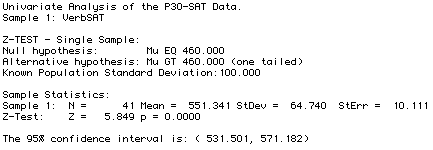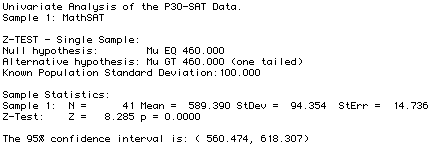-
- Overview
Topic 8 presents
the statistical procedures that permit researchers to use
a sample mean to test hypotheses about a population. These
statistical procedures were based on a few basic notions,
which are summarized as follows:
- A sample mean is expected to more or less approximate
its population mean . This permits us to use the sample
mean to test a hypothesis about the population mean.
- The standard error provides a measure of how well
a sample mean approximates the population mean. The
standard error formula is:

- To quantify our inferences about the population, we
compare the obtained sample mean with the hypothesized
population mean by computing a z-score test statistic.
The Z-Test statistic's formula is:

There is one major problem with this:
We don't usually know the population's standard
deviation, which is required to compute the z-score's
standard error.
Chapter 9 presents the statistical procedures that permit
researchers to use a sample mean to test hypotheses about
a population, when the population standard deviation
is NOT known.
These procedures use the T-Test, rather than the Z-Test.
They are based on T-Scores,
which we first met in the lecture notes for Topic
5 .
- The Logic of Hypothesis Testing
We begin by reviewing the logic of hypothesis testing that
underlies Z-Tests.
Example: We return to the example concerning
prenatal exposure to alcohol on birth weight in rats.
Lets assume that the researcher's sample has n=16 rat
pups. We continue to assume that population of normal
rats has a mean of 18 grams with a standard deviation
of 4.
Here are the four steps involved in the statistical
hypothesis test:
- State the Hypotheses:
- Null hypothesis: No effect for alcohol consumption
on birth weight. Their weight will be 18 grams.
In symbols:

- Alternative Hypothesis: Alcohol will effect birth
weight. The weight will not be 18 grams. In symbols:

- Set the decision criteria:
- Specify the significance level. We specify:

- Determine the critical value of Z. We do
this for the choosen significance level. For a non-directional
test the critical value of Z is the value that has
alpha-percent of the area more extreme than Z. For
alpha=.05 we look up a Z that has .025 of the distribution
beyond it. This is a Z of +1.96 and -1.96.
- Gather Data:
Lets say that two experimenters carry out the experiment,
and we get the following two samples of results:
| Experiment 1 |
Experiment 2 |
| Sample Mean = 13 |
Sample Mean = 16.5 |
- Evaluate Null Hypothesis:
We calculate the standard error of the mean, then calculate
Z for each experiment, and then look up the P value
for the obtained Z, and make a decision.
- T --- A Substitute for Z
The limitation of Z-Tests is that we don't usually know
the population standard deviation. What we do is:
When we don't know the population's variability,
we assume that the sample's variability is a good basis
for estimating the population's variability.
Recall, from Topic
5, that the sample variance and sample standard deviation
are unbiased estimates of the population variance and populatin
standard deviation.
The formula for the sample variance is:

The formula for the sample standard deviation is:

Using these sample values, we can estimate the
standard error of the distribution of sample means. As
stated above (and developed in Topic
8 ), the formula for the standard error is:

The estimate of the standard error is simply:

We use the estimate of the standard error to
define the T-statistic:

Note the parallelism between Z and T
| Known Population Variance |
Unknown Population Variance |
 |
 |
 |
 |
- T-Statistic
- The T-Statistic is used to test hypotheses about the
population mean when the value for the population variance
is unknown. The formula for the T-Statistic is similar
in structure to that for the Z-Statistic, except that
the T-Statistic uses estimated standard error rather
than the (unknown) standard error.
- Using T
The process of hypothesis testing when we don't know the
population standard deviation is the same as the process
when we do know it.
We have the same four steps. The only differences are
in determining the critical region and in calculating
the standard error.
- State the Hypotheses:
This step is the same as with the Z-Statistic.
- Set the decision criteria:
- Specify the significance level.
This is the same as with the Z-Statistic.
- Determine the critical value of T.
Here there is a new complication in using T: There
isn't just one T-distribution that we use to determine
the critical value of T. There is a whole family
of distributions. The distribution depends on the
"degrees of freedom", which is simply equal
to one less than the sample size. That is:

We locate the critical T value by using the T distribution
table in the Appendix.
- Gather Data.
This step is the same as with the Z-Statistic.
- Evaluate the Null Hypothesis.
We calculate the standard error of the mean using the
sample's standard deviation. Then we calculate T and
look up the P value for the obtained T and known df.
Then we make a decision.
- Determine the standard error of the mean.
The standard error is calculated by the formula:

- Calculate the Test-Statistic. The T formula
is:

Example: Eyespot Data
Many accounts suggest that many species of animals find
direct stares from another animal aversive. Some moths
have developed eye-spot patterns on their wings or bodys
to ward off predators. An experiment was done using 16
moth-eating birds. These birds were tested in a two-chambered
box that they were free to roam in from side to side.
One chamber had two eye-spot patterns painted on the wall.
The other chamber had plain walls. Each bird was left
in the chamber for 60 minutes, and the amount of time
spent in the plain chamber was recorded.
Here are the four steps involved in the statistical
hypothesis test:
- State the Hypotheses: The null hypothesis is
that there is no effect for eye-spots painted on the
wall. Birds should spend half their time -- 30 minutes
-- in each room. The alternative hypothesis is that
there is an effect. In symbols the null and alternative
hypotheses are:

- Set the decision criteria: We arbitrarily decide
on an alpha level

We also note that there are 15 degrees of freedom:

The table tells us that the critical region consists
of t values less than -2.131 and greater than +2.131.
- Gather Data:
Results:

The mean is 35 minutes in the plain side, and the sample
variance is 81.
- Evaluate Null Hypothesis:
Calculations:
The formula for the estimated standard error is:

For these data, the estimated standard error is Sqrt(81/16)
= 2.25
The formulat for T is:

Thus, for these data, T = (35-30)/2.25 = 2.22
Decision:
Since 2.22 is in the critical region, we reject the
null hypothesis that the presence of eye-spot patterns
does not influence behavior.
- Two more ViSta examples
- Z-Test: In-class survey SAT Math and Verbal data
(pop mean=460, pop stdv=100). ViSta
Data
| Report for the SAT Verbal Variable |
 |
| Report for the SAT Math Variable |
 |
- T-Test: Newcomb Lightspeed
ViSta Data
These data are from the first experiment to
determine the speed of light. The best modern
measurements correspond to a passage time of 33.02
in this experiment. The population standard deviation
is unknown.
| Report for the Newcomb Lightspeed Data |
 |
|